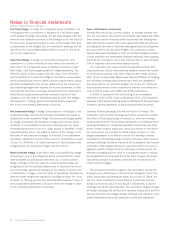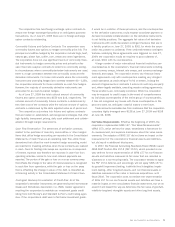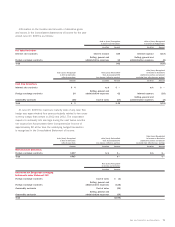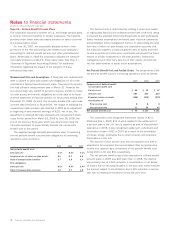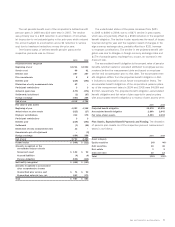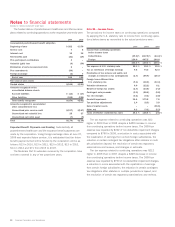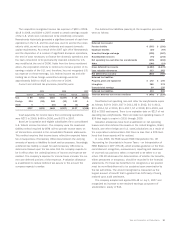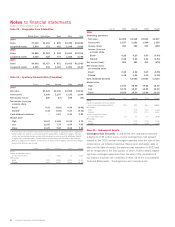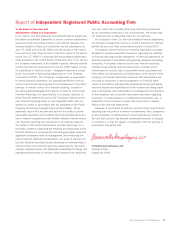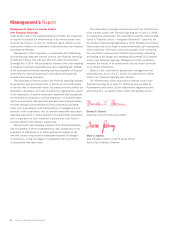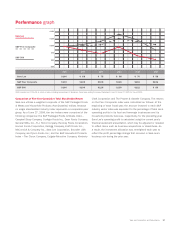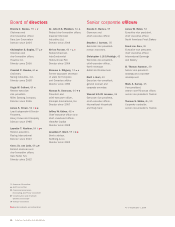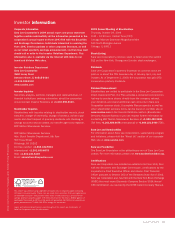Sara Lee 2009 Annual Report Download - page 84
Download and view the complete annual report
Please find page 84 of the 2009 Sara Lee annual report below. You can navigate through the pages in the report by either clicking on the pages listed below, or by using the keyword search tool below to find specific information within the annual report.
Notes to financial statements
Dollars in millions except per share data
82 Sara Lee Corporation and Subsidiaries
Due to the inherent complexities arising from the nature of the
company’s businesses, and from conducting business and being
taxed in a substantial number of jurisdictions, significant judgments
and estimates are required to be made. Agreement of tax liabilities
between Sara Lee Corporation and the many tax jurisdictions in
which the company files tax returns may not be finalized for several
years. Thus, the company’s final tax-related assets and liabilities
may ultimately be different from those currently reported.
Our total unrecognized tax benefits that, if recognized, would
affect our effective tax rate were $418 as of June 27, 2009. This
amount differs from the balance of unrecognized tax benefits as of
June 27, 2009 primarily due to uncertain tax positions that created
deferred tax assets in jurisdictions which have not been realized due
to a lack of profitability in the respective jurisdictions. At this time,
the corporation estimates that it is reasonably possible that the lia-
bility for unrecognized tax benefits will decrease by approximately
$100 – $160 in the next 12 months from a variety of uncertain tax
positions as a result of the completion of various worldwide tax
audits currently in process and the expiration of the statute of
limitations in several jurisdictions.
The company recognizes interest and penalties related to
unrecognized tax benefits in tax expense. During the years ended
June 27, 2009 and June 28, 2008, the corporation recognized
$15 and $2, respectively, of interest and penalties in tax expense.
As of June 27, 2009 and June 28, 2008, the corporation had
accrued interest and accrued penalties of approximately $111 and
$96, respectively.
The corporation’s tax returns are routinely audited by federal, state
and foreign tax authorities and these audits are at various stages
of completion at any given time. The Internal Revenue Service (IRS)
has completed examinations of the company’s U.S. income tax returns
through July 3, 2004. Fiscal years remaining open to examination in
the Netherlands include 2003 and forward. Other foreign jurisdictions
remain open to audits ranging from 1999 forward. With few excep-
tions, the company is no longer subject to state and local income
tax examinations by tax authorities for years before June 28, 2003.
In addition, in July 2009, the Spanish tax authorities announced
a challenge against tax positions claimed by the corporation’s Spanish
subsidiaries for fiscal years 2003 through 2005. We are disputing
their challenge and will continue to have further proceedings with
the Spanish tax authorities regarding this issue. There is a reason-
able possibility that the ultimate resolution will be higher or lower
than the amounts reserved.
The following table presents a reconciliation of the beginning
and ending amount of unrecognized tax benefits for the years
ended June 27, 2009 and June 28, 2008. The corporation has
adjusted its 2008 balances for certain revisions to unrecognized
tax benefits to conform to the current year presentation.
June 27, June 28,
Year ended 2009 2008
Unrecognized tax benefits
Beginning of year balance $591 $580
Increases based on current period tax positions 28 85
Increases based on prior period tax positions 22 15
Decreases based on prior period tax positions (30) (32)
Decreases related to settlements with tax authorities (10) (47)
Decreases related to a lapse of applicable
statute of limitation (7) (46)
Foreign currency translation adjustment (47) 36
End of year balance $547 $591
Note 22 – Business Segment Information
The following are the corporation’s six business segments and the
types of products and services from which each reportable segment
derives its revenues.
•North American Retail sells a variety of packaged meat and
frozen bakery products to retail customers in North America and
includes the corporation’s U.S.
Senseo
retail coffee business.
•North American Fresh Bakery sells a variety of fresh bakery
products to retail customers in North America.
•North American Foodservice sells a variety of meats, bakery,
and beverage products to foodservice customers in North America
such as broad-line foodservice distributors, restaurants, hospitals
and other large institutions.
•International Beverage sells coffee and tea products in major
markets around the world, including Europe, Australia and Brazil.
•International Bakery sells a variety of bakery and dough products
to retail and foodservice customers in Europe and Australia.
•International Household and Body Care sells products in four
primary categories – body care, air care, shoe care and insecticides –
in markets around the world, including the U.S., Europe, India and
the Asia Pacific region.
The corporation’s management uses operating segment income,
which is defined as operating income before general corporate
expenses and amortization of trademarks and customer relation-
ship intangibles, to evaluate segment performance and allocate
resources. Management believes it is appropriate to disclose this
measure to help investors analyze the business performance and
trends of the various business segments. Interest and other debt
expense, as well as income tax expense, are centrally managed,
and accordingly, such items are not presented by segment since
they are not included in the measure of segment profitability reviewed
by management. The accounting policies of the segments are the
same as those described in Note 2 to the Consolidated Financial
Statements, “Summary of Significant Accounting Policies.”


